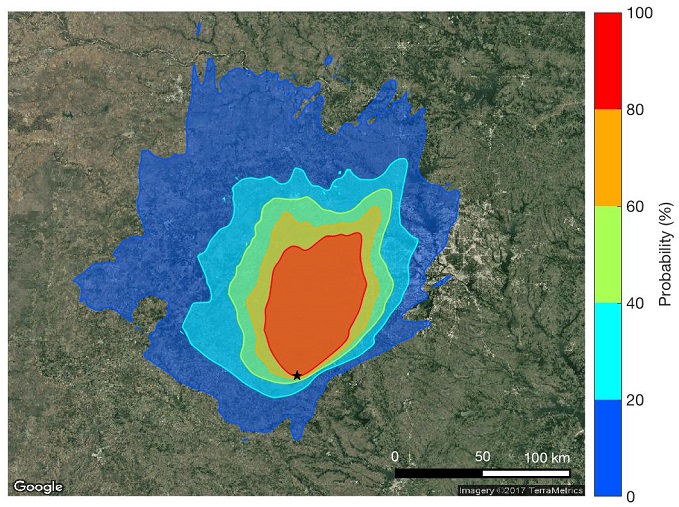Matthew Simpson (17-ERD-045)
Executive Summary
We are exploring the development of a modeling tool that will benefit LLNL missions in nuclear forensics and test ban treaty enforcement by improving radiological plume predictions. In particular, we are developing statistical methods to generate an optimal atmospheric model ensemble design to capture the key sources of meteorological uncertainty, and to generate more accurate nuclear fallout predictions.
Project Description
Currently, atmospheric model ensembles typically utilize a generic set of physics configurations that often fail to fully explore the uncertainty range of atmospheric phenomena that are key to dispersion-modeling processes, such as cloud formation, precipitation, and atmospheric stability. Better characterization of meteorological uncertainty is needed for dispersion modeling so that the plausible range of plume predictions resulting from a radiological release to the atmosphere from a nuclear detonation or release from a radiological dispersal device can be accurately communicated to decision makers. We are developing statistical methods to generate the optimal atmospheric model ensemble design to capture the key sources of meteorological uncertainty, and to generate more accurate radiological fallout predications (see figure). This methodology will be adaptive in that it will sequentially sample model physics scheme options by iteratively learning which options affect fallout pattern predictions the most. Producing probabilistic predictions that cover a full set of plausible atmospheric scenarios requires producing an ensemble of numerical atmospheric and weather model simulations, such as the Weather Research Forecasting model. Each member in such an ensemble reflects a particular configuration of physics settings (schemes) describing atmospheric processes. At the same time, the number of configurations of all possible physics schemes available for exploring is too large to explore exhaustively. As a result, it is necessary to develop a method that samples a portion of the full set of physics scheme options without a significant loss of information essential for decision making, relative to the entire set. We will focus on a class of statistical models, known as Bayesian tree models. These models will use atmospheric phenomena, such as precipitation or cloud formation, as inputs and predict concentration patterns in time and space. We will leverage LLNL's expertise in numerical weather prediction, fallout dispersion modeling, and statistical methods. Lawrence Livermore has the high-performance computing resources and data storage capacity required to research and develop statistical methods that optimally generate these probabilistic fallout predictions.
Successful completion of this research project will generate a robust, statistical-based radiological fallout modeling system that will quickly produce probabilistic plume predictions. Using statistical methods, we expect to develop software and computer modeling tools that will result in highly accurate base-case radiological concentration predictions and provide the range of physically plausible concentrations from meteorological uncertainty. Specifically, the research goals include (1) building a statistical model to predict dry and wet deposition concentration patterns from meteorological phenomena, (2) defining the threshold metric(s) for the concentration patterns and use the metric(s) in conjunction with the Bayesian tree model to perform adaptive sampling of the physics schemes, and (3) demonstrating the capability to efficiently generate accurate probabilistic fallout patterns from a variety of release scenarios and scales. The modeling tool developed during this project will have a beneficial impact on LLNL missions in nuclear forensics and test ban treaty enforcement by improving radiological plume predictions, and will enhance Livermore's status in radiological-plume modeling. In addition, the nation's security emergency response will be improved by the accuracy of atmospheric dispersion predictions and developing methods to reliably generate probabilistic estimates of radiological fallout contamination. Although we will focus on improving radiological plume modeling for national security, atmospheric modeling for renewable energy will also benefit from this work. The statistical methods developed for generating optimized weather ensembles can also be applied to predict wind and solar power generation.
Mission Relevance
The atmospheric modeling tool we are developing supports the Laboratory's core competency in Earth and atmospheric science relevant to the prediction of radioactive fallout patterns or to renewable energy resources. Additionally, our probabilistic modeling methodology is aligned with the core competency in high-performance computing, simulation, and data science, and supports DOE and NNSA goals to reduce global nuclear security threats.
FY17 Accomplishments and Results
During FY17 we (1) determined that identifying existing, and potentially defining new comparison metrics, are essential steps in developing methods to efficiently populate an ensemble design for improved real-time fallout prediction; (2) performed a scientific review of statistical metrics for comparing different radiological fallout concentration patterns; and (3) generated numerical atmospheric model domains and assembled the necessary initialization data to perform our nuclear fallout simulations.






